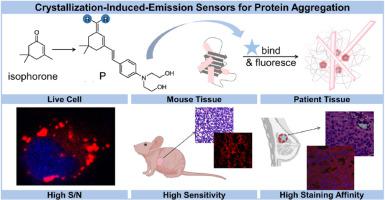当前位置:
X-MOL 学术
›
Anal. Chim. Acta
›
论文详情
Our official English website, www.x-mol.net, welcomes your feedback! (Note: you will need to create a separate account there.)
Isophorone-based crystallization-induced-emission sensors detect proteome aggregation in live cells and tissues with breast cancer
Analytica Chimica Acta ( IF 5.7 ) Pub Date : 2024-06-26 , DOI: 10.1016/j.aca.2024.342916 Xiaomeng Jia , Di Shen , Jintai Deng , Kainan Wang , Xueqing Wang , Yijin Guo , Lu Sun , Hao Jin , Qiuxuan Xia , Huan Feng , Biao Jing , Jialu Sun , Wang Wan , Yu Liu , Man Li
Analytica Chimica Acta ( IF 5.7 ) Pub Date : 2024-06-26 , DOI: 10.1016/j.aca.2024.342916 Xiaomeng Jia , Di Shen , Jintai Deng , Kainan Wang , Xueqing Wang , Yijin Guo , Lu Sun , Hao Jin , Qiuxuan Xia , Huan Feng , Biao Jing , Jialu Sun , Wang Wan , Yu Liu , Man Li

|
Protein misfolding and aggregation can lead to various diseases. Recent studies have shed light on the aggregated protein in breast cancer pathology, which suggests that it is crucial to design chemical sensors that visualize protein aggregates in breast cancer, especially in clinical patient-derived samples. However, most reported sensors are constrained in cultured cell lines. In this work, we present the development of two isophorone-based crystallization-induced-emission fluorophores for detecting proteome aggregation in breast cancer cell line and tissues biopsied from diseased patients, designated as A1 and A2. These probes exhibited viscosity sensitivity and recovered their fluorescence strongly at crystalline state. Moreover, A1 and A2 exhibit selective binding capacity and strong fluorescence for various aggregated proteins. Utilizing these probes, we detect protein aggregation in stressed breast cancer cells, xenograft mouse model of human breast cancer and clinical patient-derived samples. Notably, the fluorescence intensity of both probes light up in tumor tissues. The synthesized isophorone-based crystallization-induced-emission fluorophores, A1 and A2, enable sensitive detection of protein aggregation in breast cancer cells and tissues. In the future, aggregated proteins are expected to become indicators for early diagnosis and clinical disease monitoring of breast cancer.
中文翻译:

基于异佛尔酮的结晶诱导发射传感器检测乳腺癌活细胞和组织中的蛋白质组聚集
蛋白质错误折叠和聚集可导致多种疾病。最近的研究揭示了乳腺癌病理学中的聚集蛋白,这表明设计能够可视化乳腺癌中蛋白质聚集体的化学传感器至关重要,尤其是在临床患者来源的样本中。然而,大多数报道的传感器仅限于培养细胞系。在这项工作中,我们开发了两种基于异佛尔酮的结晶诱导发射荧光团,用于检测乳腺癌细胞系和患病患者活检组织中的蛋白质组聚集,指定为 A1 和 A2。这些探针表现出粘度敏感性,并在结晶状态下强烈恢复荧光。此外,A1和A2对各种聚集蛋白表现出选择性结合能力和强荧光。利用这些探针,我们检测应激乳腺癌细胞、人类乳腺癌异种移植小鼠模型和临床患者来源的样本中的蛋白质聚集。值得注意的是,两种探针的荧光强度在肿瘤组织中都会亮起。合成的基于异佛尔酮的结晶诱导发射荧光团 A1 和 A2 能够灵敏地检测乳腺癌细胞和组织中的蛋白质聚集。未来,聚集蛋白有望成为乳腺癌早期诊断和临床疾病监测的指标。
更新日期:2024-06-26
中文翻译:

基于异佛尔酮的结晶诱导发射传感器检测乳腺癌活细胞和组织中的蛋白质组聚集
蛋白质错误折叠和聚集可导致多种疾病。最近的研究揭示了乳腺癌病理学中的聚集蛋白,这表明设计能够可视化乳腺癌中蛋白质聚集体的化学传感器至关重要,尤其是在临床患者来源的样本中。然而,大多数报道的传感器仅限于培养细胞系。在这项工作中,我们开发了两种基于异佛尔酮的结晶诱导发射荧光团,用于检测乳腺癌细胞系和患病患者活检组织中的蛋白质组聚集,指定为 A1 和 A2。这些探针表现出粘度敏感性,并在结晶状态下强烈恢复荧光。此外,A1和A2对各种聚集蛋白表现出选择性结合能力和强荧光。利用这些探针,我们检测应激乳腺癌细胞、人类乳腺癌异种移植小鼠模型和临床患者来源的样本中的蛋白质聚集。值得注意的是,两种探针的荧光强度在肿瘤组织中都会亮起。合成的基于异佛尔酮的结晶诱导发射荧光团 A1 和 A2 能够灵敏地检测乳腺癌细胞和组织中的蛋白质聚集。未来,聚集蛋白有望成为乳腺癌早期诊断和临床疾病监测的指标。









































 京公网安备 11010802027423号
京公网安备 11010802027423号